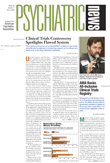African Americans attending colleges and universities in the Washington, D.C., area report seasonal changes in mood, energy, appetite, weight, and sleep similar to those of the general population living at the same latitude.
Students from Africa enrolled in the same colleges and universities may have a higher prevalence of summer-type seasonal affective disorder (SAD) than African-American students do.
These findings, part of a study of seasonality in different ethnic and racial groups at different latitudes, were reported at APA's 2004 annual meeting in May by Teodor Postolache, M.D., an associate professor of psychiatry at the University of Maryland School of Medicine in Baltimore. Postolache leads a multidisciplinary team that studies interactions between biological rhythms and the environment.
Results from the group's survey of seasonal variation of mood and behavior in African-American students appear in the June American Journal of Psychiatry.
This is the first study of seasonality in African Americans, Postolache said, and the largest American study of seasonality in college students.
In this research, Charles Agumadu, M.D., an extern from Nigeria, along with Courtney Thrower, a psychology student, and others asked undergraduate and graduate students who identified themselves as African Americans at four colleges and universities in Washington, D.C., to complete the Seasonal Pattern Assessment Questionnaire, a standard epidemiological assessment tool. Of 646 students contacted, 597 returned the questionnaires, and 537 (83 percent) completed all sections.
Only 19 percent of the students described any seasonal changes. About 15 percent reported one or more syndromal symptoms or milder subsyndromal symptoms associated with winter seasonal affective disorder (SAD). These symptoms include depressed feelings, lowered energy, increased craving for carbohydrates, weight gain, and increased need for sleep. The symptoms appear in the fall, as hours of daylight decrease, and remit in spring, as hours of daylight lengthen.
About 5 percent of the students reported symptoms associated with summer SAD, also ranging in severity. These symptoms include mild to moderate recurrent depression, agitation, insomnia, decreased appetite, and weight loss in summer months. Symptoms remit in the fall.
Winter SAD has been tied to sensitivity to light deficiency, Postolache noted. Timed exposure to daylight-equivalent artificial light is the first-line treatment for this disorder.
The mechanism for summer SAD is less well understood; some researchers believe it involves a reaction to heat. The disorder has been largely neglected, Postolache asserted. Treatment for summer SAD may include swimming in a cool pool or staying indoors in an air-conditioned environment.
Several studies show about 10 percent to 20 percent of people living at the same latitude as Washington, D.C., have mild symptoms of winter SAD, and 1 percent to 4 percent can be diagnosed with the disorder. The prevalence of summer SAD, while still unclear, is lower in northern latitudes and higher near the tropics.
Research by others suggests ethnicity may be linked to relative protection or vulnerability to seasonal changes, Postolache noted. Icelanders and Lapps, for example, have lower rates of winter depression than many other populations do. The Chinese and Japanese may have higher rates of summer depression. Although heritability may influence vulnerability to seasonal changes, Postolache said, epidemiological studies suggest cultural/environmental factors also may play a contributory role.
In his talk at APA's annual meeting, Postolache described findings from a similar survey of 246 African students coordinated by Samina Yousufi, M.D., a psychiatry resident at St. Elizabeths Hospital in Washington, D.C.
The African students came from Senegal, Gambia, Sierra Leone, Liberia, Ivory Coast, Ghana, Togo, Benin, Nigeria, Angola, Gabon, and Cameroon, countries on the west coast of Africa, home to ancestors of most present-day African Americans. All had lived in the Washington, D.C., area for at least three years.
Based on previous studies suggesting that people who move from lower to higher latitudes have a higher prevalence of winter SAD than the indigenous population, the researchers expected the African students would report more winter SAD symptoms than African-American students did. They also hypothesized that Africans, presumably well adapted to heat, would have lower rates of summer SAD than their American peers.
They were wrong on both counts, Postolache said.
African students reported no higher frequency of winter SAD symptoms than had the African Americans. More African students reported summer SAD symptoms, although the small numbers, he said, require replication in larger samples.
Two opposing hypotheses may explain these results, Postolache suggested. People who move or travel to a novel climate may be more or less affected by their new environment if the climate at the two sites varies substantially. Alternatively, people may become sensitized and more reactive over time to elements of their native environment.
Awareness of SAD and gender influenced the reported degree of seasonality among the two groups of students. Of the 27 percent of Africans and 20 percent of African Americans who had heard of SAD, African men and African-American women had higher global seasonality scores than African women and African-American men. Lack of awareness of SAD, Postolache said, suggests that those with symptoms may delay or not seek professional help.
About 32 percent of the African students but only 19 percent of the African Americans perceived seasonal changes as problems. The two groups may identify and report problems differently, Postolache noted. The stress of immigration may worsen African students' perception of difficulties in general.
The researchers plan future surveys to compare African and African-American students with college students from other ethnic and racial backgrounds. They also will conduct a treatment trial of light therapy in African-American women. ▪
